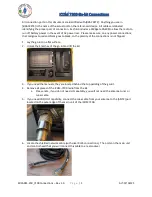
Page
7
of
25
ears while you do this!), then the BPF peaking has probably worked well. This signal strength is independent of volume
control setting. If the signal strength is less than 7, or if there is no peak, then it is necessary to investigate further.
If the peak in BPF occurs with the trimmer capacitor fully open, or fully closed, then it is necessary to add or remove turns
from the T1 transformer. This is described in detail in the manual, so please refer to the relevant section.
I-Q and Phase balance fail to show a minimum
Now check the unwanted sideband alignments:
8.8 I-Q bal.
8.9 Phase Lo
8.10 Phase Hi
Note that the displayed signal strength level unfortunately depends on the volume control setting, because the ADC for
these weak signal (unwanted sideband) measurements is tapped from the signal path AFTER the gain control. It would
have been nice if this was not the case, but it would have required another op-amp.
If the displayed signal strength is 12 or 13, then this is too HIGH, it means the ADC is saturated and it will not show
anything meaningful. So turn down the volume a bit.
If the displayed signal strength is 1 or 2, then the signal strength bar will jump around too much because you will mostly
be measuring noise rather than the signal - so, turn the volume up a bit.
Once you have the signal strength display of a reasonable magnitude, you should be able to make the adjustments as
described in the relevant manual sections. If you do not get the right signal strengths or if you do not manage to see any
minimum, which should be quite easily seen, then it is time to investigate further with some proper signal tracing through
the receive path. If there is a fault in the I or Q channels, then there will be no unwanted sideband cancellation, and no
minimums can be found. So a fault somewhere in the I or Q signal paths is the usual cause of not finding a minimum.
Signal generation by the Si5351A
When in the menu "8.7 Peak BPF", we can use this to trace the signal generator output, which is Clk2 of the Si5351A IC1,
all the way through the Receive path to the earphones. The Clk2 output of IC1 feeds into the IC3c NAND gate, at IC3 pin
10. During signal generation mode, to inject the signal into the receivers input (right at the RF connector of the
transceiver), the NAND gate is enabled by the processor signal "SIG OUT". Then the 5V peak-peak squarewave coming
out of IC3 pin 8 is routed to the RF connector through the 120K resistor R43.
This is what it looks like on my oscilloscope, at IC3 pin 8. Note the horizontal speed 50ns/div, and the signal frequency
measurement on the 'scope, 10.120MHz - this was on a 30m QCX kit. Don't worry too much that is is not a precise-
looking square wave. 'Scope probes, long wires, 'scope bandwidth... long story, out of the scope (pun not intended) of this
article.








































